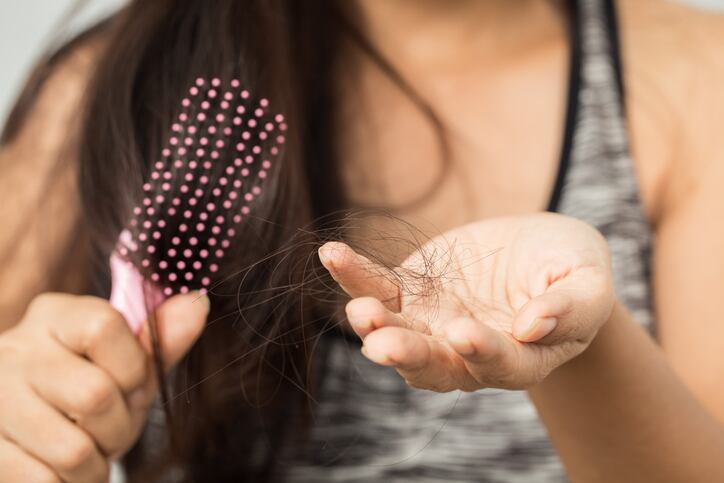Conducted by researchers in India and US, the hair serum containing amla extract, freeze-dried coconut water, selenium, sandalwood odorant and peanut shell extract, was found to be a safe and effective alternative to manage hair thinning and induce hair growth.
Published in the Clinical, Cosmetic and Investigational Dermatology journal, the study was funded by Sami Labs Limited and Sabinsa Corporation.
One of the authors of the study, Shaheen Majeed, who is also president at Sabinsa, said: “The effects of hair loss can be emotionally consequential. Though herbs and more recently herbal extracts have been used in hair care, this combination of ingredients offer a synergistic activity, as each of them have a different mechanism for protecting and nourishing hair follicles.”
Majeed said this was the firm’s first human clinical trial of the hair serum formulation.
The hair serum formulation is currently licensed to Johara Cosmetics, a skin care line under Sabinsa and Sami Group, but Sabinsa plans to license it to customers worldwide, under the trademark, AMIFERA soon.
Study design
The open-label study recruited 42 healthy participants with self-perceived hair fall. Subjects were between 25 to 45 years and have grades three to six severity of hair loss according to a MSCR 10-point photo numeric scale.
Participants were tasked to do a two-week washout period, where they were provided with a neutral shampoo and instructed not to use more than thrice a week.
After two weeks, baseline assessments were performed (day 0), and subjects were given the hair serum.
Males were tasked to use 2mL and females 3.5mL once daily at night by partitioning the hair into parts as a leave in serum.
The study period was three months and participants were instructed to continue using the neutral shampoo.
TrichoScan was used to measure hair growth rate and hair density. Hair thinning and hair fall reduction was assessed by dermatologists and a self-assessment questionnaire.
Dermatologists used the hair comb test and hair pull test to evaluate hair thinning and hair fall reduction. The hair pull test determines how tightly hair is anchored to the hair papilla.
The hair serum contains amla extract (Saberry), freeze-dried coconut water (Cococin), and the micronutrient selenium [PeptiSeLect] (γ-L-Glutamyl-L-selenomethionine), sandalwood and peanut shell extract, provided by Sabinsa.
Strong hair, less fall
The findings revealed that mean hair density rate significantly improved from 171.35 ± 21.9 per cm2 to 185.01 ± 20.57 per cm2 after 90 days. Improvements were seen as early as day 30.
Hair growth rate was found to significantly improved at day 30, 60 and 90 compared to baseline.
The hair pull test significantly reduced the mean number of hairs removed per pull from 2.27 to 1.33 (41.4%) at the end of the study compared to baseline. Changes were noticed as early as day 30.
Hair fall with and without bulb were significantly lesser at day 60 and 90 compared to baseline. The reduction of hair fall with bulb was 57.53% and without bulb was 81.60% at the end of the study.
Majeed explained that hair fall without the bulb is the breaking of hair from the middle, leaving the root intact. “When a bulb is present on the end of a hair strand, it means that the hair was lost closer to the root. This is indicative of a telogen phase hair. This is also normal as loss of hair occurs at the end of telogen phase.
“You may also find more hair loss with bulbs when hair enters a telogen phase prematurely, with loss of active growth, which can result in a diffuse thinning of hair known as telogen effluvium.”
The study also observed that hair thinning was significantly improved at day 60 (7.03%) and day 90 (17.55%) compared to baseline.
Hair boosting ingredients
The hair serum contained ingredients that provided the therapeutic benefits in preventing hair fall and promoting hair growth, but is gentle on the scalp and does not contain parabens, formaldehyde, and synthetic dyes.
None of the subjects experienced adverse events including erythema, allergic reactions, folliculitis, oiliness, burning, and boils on the scalp.
Amla extract, also known as Indian gooseberry, is extracted from the fruits of the plant Emblica officinalis. It has been shown to stimulate hair growth and make hair softer and shinier.
Coconut is known to condition hair, prevent split ends, reduce frizz, control flaky scalp, and dandruff.
Peanut shell extract prevents itching and allergy, while selenopeptide helps in hair growth and prevents hair loss.
Sandalwood was studied in previous research for its hair fall reduction and promotion of hair growth properties.
The results of this study showed that the application of the hair serum formulation on healthy male and female volunteers with moderate hair loss for three months was safe and effective.
Hair fall is a common and stressful symptom, distressing the quality of life of an individual.
Majeed said as the hair serum was used on individuals with moderate hair loss (rank 6 on the MSCR 10-point photo-numeric hair thinning scale), the results are encouraging, and researchers felt that the product may benefit individuals experiencing severe hair loss.
“We would like to add that hair fall can be due to several reasons. Lack of proper nutrients in the diet, medications, medical conditions such as PCOD, hypothyroidism and of course genetic predisposition. In many cases, nutritional supplements may be helpful along with this type of hair serum application.”
Majeed said the limitations in this study were inherent with its open label design. “To limit such bias, we used instrument (Trichoscan and VISIA CR imaging) evaluations to understand the hair density, volume and other parameters. We may conduct larger studies in future.”
He added a larger sample size, longer duration, and wider population range in a comparative study design could validate its clinical study.
Source: Clinical, Cosmetic and Investigational Dermatology, Dove Press
https://doi.org/10.2147/CCID.S271013
“Clinical Study to Evaluate the Efficacy and Safety of a Hair Serum Product in Healthy Adult Male and Female Volunteers with Hair Fall”
Authors: Muhammed Majeed, Shaheen Majeed, et al.


